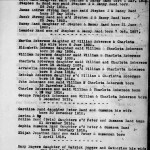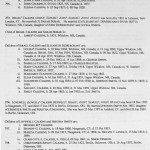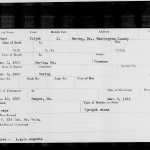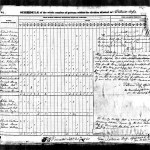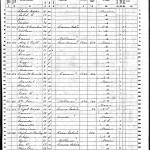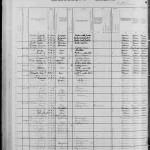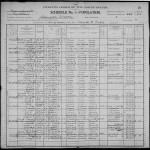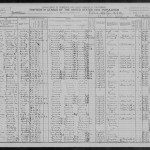(Me-F-M-M-M-M-Them)
Military Record of Elijah J. Rand, Union Army.
Rand Military Record – The first page of this military record lists soldiers name as Elijah Rand of Company F, 22nd Maine Volunteer Infantry Regiment. The second page lists that there includes 1 Casualty sheet and 1 page of Misc. Information. Page three is when we start to get at the heart of this paperwork. This is the casualty sheet. Lists Elijah Rand, a private in Co. F 22nd Maine Volunteers and his casualty as death. This page was certified by Capt. William B. Taylor of same company and that the date of discharge was March 3, 1863 in Baton Rouge, Louisiana. He had no effects on him. On page 6, part 1 it states that Elijah Rand died March 2, 1863 of chronic diarrhea (perhaps dysentery?). Part 2 is a muster Roll for Feb. 28, 1863 to June 30, 1863. It also states that he joined on September 10, 1862 in Barring, Maine for a period of 9 months. Part 3 states that he was 44 years old and was mustered out of the regiment in Bangor, Maine on Aug. 14, 1863 due to death. Part 4 is a muster roll stating that he was present for Jan. & Feb. 1863. Page 7, part 1 is a muster roll for Nov. and Dec. 1862, for which he was present. Part 2 is a muster roll dated Oct. 31, 1862, for which he was present. Part 3 states that he is 44 and that he was in Camp John Pope in Bangor Maine on Oct. 10, 1862. This means of the 9 months that he signed up, he was in the army for 5 months and 22 days.
Wikipedia gives a service calendar for the 22nd. It states that “the 22nd Maine Infantry was organized in Bangor, Maine and mustered in October 10, 1862 for nine months’ service under the command of Colonel Simon G. Jerrard. The regiment left Maine for Washington, D.C., October 21. Duty at Arlington Heights, Virginia, until November 3. Moved to Fortress Monroe, Virginia, November 3, then to Ship Island, Mississippi, and New Orleans, Louisiana, December 2-15. Attached to Grover’s Division, Department of the Gulf, to January 1863. 1st Brigade, 4th Division, XIX Corps, Army of the Gulf, to July 1863. Moved to Baton Rouge, Louisiana, January 16, 1863. Duty there until March. Operations against Port Hudson, Louisiana, March 7-20. Moved to Donaldsonville March 26, then to Brashear City. Operations in western Louisiana April 9-May 14. Teche Campaign April 11-20. Porter’s and McWilliams’ Plantations at Indian Bend April 13. Irish Bend April 14. Moved to Franklin April 15. Bayou Vermillion April 17. Moved to New Iberia April 25; to Washington May 6, then to Brashear City May 11-27. Moved to Port Hudson May 28. Siege of Port Hudson June 1-July 8. Assault at Port Hudson June 14. Surrender of Port Hudson July 8. Ordered home July 24. The 22nd Maine Infantry mustered out of service August 14, 1863.”
It also states that “the regiment lost a total of 180 men during service; 1 officer and 8 enlisted men killed or mortally wounded, 2 officers and 169 enlisted men died of disease.”
This means that Elijah arrived after Baton Rouge had been captured on Aug. 1862, spent his entire time in the city since Jan. 1863 and died just before the regiment moved on to the Port Hudson siege. His regiment was decimated by disease and he may have seen no combat at all.
——————————————————————————————————————-
Pension Record of Eunice A. Rand.
Upon receiving this record, I immediately disarranged the pages. I have since placed them in an order that seems to work, dividing them into 3 parts.
Rand Pension 1 – Page 1 is a title page. Pages 2 & 3 are the petition by Eunice Rand to the Court for the city of Calais in Washington Co., Maine. Page 2 states that on July 16, 1863 she was 39 years old. It lists Elijah’s death date as March 1, 1863. It states “that he died suddenly of some disease to this applicant unknown contracted by him while in the service of the United States in the time of his duty in the Company aforesaid, having been up to within a few moments of his death in good health, he fell suddenly dead in camp.” She was married on Sept. 10, 1840 by Elias Kelsey, Justice of the Peace. She had the following children: Sarah Ann Rand (22), Susannah (21), Caroline (19) [later a wife of Emmons Williams], Lucinda J. (16), Henrietta (13), Adoniram (11), and Elijah (an infant). She appointed Enoch B. Harvey her attorney. In this application, she marks her name with an X rather than just writing it, indicating illiteracy. In both the 1900 & 1910 Census, she stated that she could both read and write. She must have learned somewhere. Page 3 also contains the confirmation from her two witnesses, Archibald Blacklock and William Sears. Page 5 lists the evidence that she presented. Page 6 is a copy of her wedding certificate from Calais, Maine. Page 7 indicates the application was received. Page 8 is a letter stating that the Adjutant General’s office had received the pension application. Page 9 states that Eunice Rand received $8 per month commencing on March 20, 1863. Page 10 is cover letter for a widow’s application for increase in pension in 1866-67. This increase was for Adoniram (being younger than 16) for an extra $2 per month. On page 11, the only new information is that her pension no. is 19436. Also, that Adoniram was born in Eastport, ME on July 23, 1852.The two witnesses are now Andrew L. Todd of Calais and Rachel Russell of Baring, who have been acquainted with Eunice for 8 years. Page 12’s claim does not list infant Elijah, who may have passed away. Page 13 is a letter from the Clerk of Eastport, Maine on Oct. 15, 1867 certifying the birth of Adoniram Rand.
Rand Pension 2 – Page 1 states that on Dec. 4, 1882 Eunice was dropped from her pension for failure to send in her widow’s claim. Page 2 is a cover letter for the restoration of a widow’s pension. Page 3 is part of the application where her lawyer is now named Gardner. Page 4 is a letter from the Treasury Department stating that she had received payments up to Sept. 1879. Page 6 & 7 is her declaration that she failed to enroll “by reason of absence from home and living among strangers in the capacity of a nurse in Boston and Hyde Park at Massachusetts and in other places.” Her attorney is now George R. Gardner of Calais, with witnesses Henry A. Balcom and Ernest D. Morrill, both of Calais. Page 8 is a letter showing the evidence of widowhood. Page 9 & 10 is a letter from Emmons Williams as a recommendation of her character. Emmons was also her son-in-law as seen in the 1880 Census, having married her daughter Mary Caroline. Page 10 is a notarized statement of same. Page 11 is a letter for the same recommendation by W.D. Haines of Readfield, Maine. Page 12 is by her long term employer, Henry Blasdale, a banker in Boston. Page 13 is a notarized stamp for his statement. Page 14 is a letter by Rhoda R. Gardiner of Hyde Park, MA as a second witness of Eunice’s character in Boston. Page 17 is a letter by Department of the Pension Bureau that payments will begin and those payments on hold since September 1879 we be sent.
Rand Pension 3 – Page 1 is a statement that according to the Pension Bureau, payments will increase to $12 per month commencing on March 19, 1886. Page 2 is a voucher for $36 sent to Boston. Page 4 is a letter that Eunice sent stating that she is making a claim on $36 paid from Sept. 4, 1909 to Dec. 4, 1909. She must have been getting paid quarterly. Page 5 is a statement that the Sept. 4, 1914 check was returned to the Pension Bureau because of the pensioner’s death on Aug. 27, 1914. Page 6 is a letter dated the day after Eunice’s death by her daughter, Sarah A. Bohanon, seeking reimbursement for Eunice’s expenses. Page 7 is a letter from C.L. Brown, Postmaster, to the Bureau seeking information on the pension for Ray Bohanon (Sarah’s son & Eunice’s grandson). It was dated Sept. 7, 1914. Pages 11-17 encompass her reimbursement application. The application indicates that Sarah A. Bohanon is 73 and lives in Alexander, ME. It states that no sick or death benefits were paid for pensioner. Eunice also had no insurance (life, accident, or health) at time of death. At her death, Eunice left no money, real estate, or personal property. Sarah states that she is the daughter of the deceased and that “my husband is dead.” Eunice died of paralysis of the bowels and that the sickness began on May 1, 1914 and that her doctor was Ira Everett Dyas, M.D. Eunice was living with Sarah in Alexander, ME during her sickness and died there as well. She was buried in the family lot at Baring, ME. Record indicates that I.E. Dyas was paid $43 as her physician. Sarah A. Bohanon claimed no charge as her nurse. John Gillis Co. was paid $51.25 as undertaker. Finally, William Higgins was paid 3.50 for burial. Witnesses to this application were Hezekiah King and Lucy A. Knowles (Eunice’s granddaughter), who said that they saw Sarah sign this document and that both knew Eunice for over 20 years. Page 15 is the bill of the funeral parlor, John Gillis Co. A great many of my relatives were buried by this firm. Page 16 is from the grave-digger, William Higgins, indicating he had been paid in full. Page 17 was from Dr. Dyas laying out the charges for his services. Page 18 is a cover page indicating reimbursement was allowed and that Eunice had been dropped from the rolls due to death.

